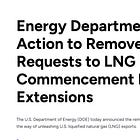3 reasons why American refineries are flagship models for cutting emissions without cutting corners
From smokestacks to clear skies and how U.S. refineries cut emissions 90% while powering a Nation
TL;DR: U.S. refineries have slashed emissions by about 90% since the Clean Air Act of 1970--sulfur dioxide (SO2) down as much as 95%, nitrogen oxides (NOx) by around 70%, and other pollutants by 80-90%--all while fueling America’s rise as an energy superpower.
In 1970, America’s refineries were the beating heart of an industrial giant, turning crude into the gasoline and diesel that powered our cars, trucks, and dreams. They were also pumping out serious pollution--31 million tons of SO2 and 27 million tons of NOx nationwide. Say hello to the Clean Air Act, a bold move by a nation determined to breathe easier without choking its energy backbone. Fast forward to April 2025, and the numbers are staggering: refinery emissions are down roughly 90%. This right here is a testament to American ingenuity, proving we can lead the world in energy production and clean air at the same time.
1970 was when American refining showed power and progress
First off, full disclosure… I was born in 1989, so I’m taking the internets word about 1970!
Back in ‘70, the U.S. was already an oil and gas titan, with refineries humming across the Gulf Coast and beyond. The Clean Air Act didn’t aim to kneecap that strength… it set out to refine it. New rules demanded pollution controls like scrubbers and catalytic converters, and states rolled up their sleeves to meet air quality goals. By 1990, refinery emissions had dropped about 50%, even as output kept climbing. National SO2 fell 26%, and NOx started trending down too. Was it perfect? No. But it showed America could tackle pollution without dimming its energy edge.
This wasn’t about shutting down plants, it was about making them better. Refineries adapted, proving that the U.S. could power its economy and clean its skies in one go. That grit laid the groundwork for what came next.
1990-2010 was when mighty American energy met environmental muscle
The 1990 Clean Air Act amendments turned up the heat, and American refineries rose to the challenge. Armed with tougher standards and tech like Maximum Achievable Control Technology (MACT), the industry slashed emissions by 80% between 1990 and 2010, according to a 2013 study by Nelson. SO2 from refineries? Down as much as 95% since 1970. NOx? Likely 70% lower. Nationally, SO2 hit 1 million tons by 2020…a 97% drop… while refineries kept churning out nearly 18 million barrels a day.
This was peak American balance: environmental law pushing innovation, and the oil and gas sector delivering. The EPA’s Petroleum Refinery Initiative locked in settlements that cut emissions further, but let’s be real—refineries didn’t just comply; they thrived. Capacity grew 50% since 1970, per the Energy Information Administration, proving that cleaner doesn’t mean weaker. This was U.S. energy flexing its muscle and supplying the world while slashing pollution per barrel.
2010 to today has been a legacy of strength and stewardship
Since 2010, the momentum’s held steady. Rules like the EPA’s Greenhouse Gas Reporting Program have nudged emissions down another estimated 10%, landing us at that 90% total drop since 1970. SO2’s practically a ghost story now, VOCs and particulate matter are down 80-90%, and NOx keeps falling. All this while America’s become the globe’s top oil producer, pumping out more energy than ever.
This isn’t a fluke--it’s the U.S. doing what it does best: innovating under pressure. Refineries today are marvels of engineering, balancing raw power with responsibility. Environmental laws gave them a shove, sure, but American know-how—think scrubbers, catalysts, and sheer determination—made it happen.
American energy and environmental law that makes sense is possible
Let’s cheer the victories: a 90% emissions drop is a big deal. It’s cleaner air, healthier kids, and a stronger case for American energy independence. The Clean Air Act didn’t kill jobs or cripple oil and gas--it sharpened them. Refineries are proof that regulation, when smart, can coexist with industry. The U.S. now exports energy worldwide, from LNG to refined products, and does it with the sightest fraction of the pollution we saw in 1970.
But balance means owning the flip side. Tree huggers will say it’s not enough--greenhouse gases like CO2 (i.e. plant food) are still a thing, and refining’s carbon footprint isn’t shrinking as fast as SO2 did. Fair point. Oil and gas aren’t going “green” 🤪 overnight, and they shouldn’t have to--America runs on this stuff. The trick is keeping the wins coming without strangling an industry that employs millions and keeps the lights on. Too much red tape could stall progress; too little could undo the gains. The Clean Air Act found a sweet spot and future laws need to do the same.
Here’s why it matters
This story isn’t just about numbers….. it’s about America’s DNA. We’re a nation that builds, powers, and adapts. Refineries cut emissions by 90% not because we gave up on energy, but because we doubled down on doing it right. That’s the U.S. edge: we don’t just produce--we innovate. Oil and gas aren’t fossils; they’re pillars of a modern economy that’s cleaner and stronger than ever.
So next time you fill up your tank, tip your hat to the refineries, the blue collar workers, and the laws that got us here. America’s energy future is bright, and it’s a heck of a lot cleaner than its past.
Sources:
EPA’s “National Air Pollutant Emission Trends, 1900-1998”
“The Benefits and Costs of the Clean Air Act, 1970 to 1990”
Nelson’s “An examination of historical air pollutant emissions from US petroleum refineries”
EPA Greenhouse Gas Reporting Program
EIA Refinery Capacity Report
EPA Air Pollutant Emissions Trends Data





